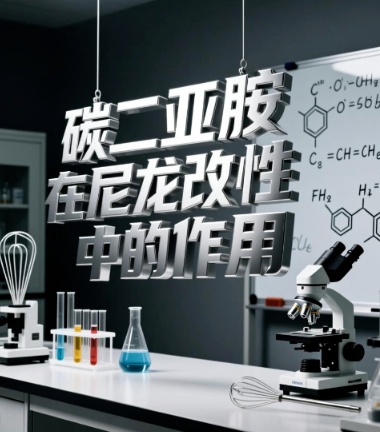The role of carbodiimide in nylon modification

Carbodiimide (commonly abbreviated as CDI or CA) plays a crucial role in the modification of nylon (especially PA6 and PA66).Efficient hydrolysis stabilizer。
Key function: Hydrolytic stabilizer
The main chain of nylon molecules contains a large number of amide bonds (-CO-NH-), which, while giving nylon excellent strength and toughness, are prone to occur in high temperature and high humidity environments.Hydrolytic degradationThis process can be simply understood as water molecules attacking and breaking the amide bond, resulting in:
1. Molecular chain breakageMolecular weight decreases.
2. Rapid deterioration of mechanical propertiesThe strength, toughness, and modulus decrease significantly.
Product failureBrittleness and cracking problems occur.
The role of carbodiimide is to actively "capture" and "eliminate" those destructive factors that can cause and accelerate hydrolytic degradation.
Mechanism of Action: Chemical "Scavenger"
The carbodiimide molecule contains highly unsaturated-N=C=N-Functional group, it has very high reactivity and can preferentially react with the water-released.Carboxyl group (-COOH)Reaction occurs.
The mechanism of action can be divided into two steps:
Inhibit the autocatalytic hydrolysis process.
At the initial stage of hydrolysis, nylon generates some carboxylic acid end groups (-COOH). These carboxylic acid end groups can catalyze the hydrolysis of adjacent amide bonds more quickly, producing more carboxyl groups, forming a...Self-catalytic accelerationThe vicious cycle. Carbodiimide can rapidly react with these carboxyl groups to form stable N-acylurea, therebyThe catalyst for the hydrolysis reaction was removed.This fundamentally curbed the acceleration of the hydrolysis reaction.
"Repair" broken molecular chains (secondary effect)
In theory, carbodiimide can react with carboxyl groups and isocyanate end groups (-NCO, another cleavage product) generated after hydrolysis, playing a certain role in "sewing" molecular chains. However, in practical applications, its main contribution is considered to be...Terminate the autocatalytic process....rather than significantly increasing the molecular weight.
Chemical equation simplified representation:R'-N=C=N-R'' + R-COOH → R'-NH-CO-N(R)-CO-NH-R''
(R-COOH represents the carboxylic acid produced by the hydrolysis of nylon)
Through this reaction, the destructive carboxyl group is converted into a stable and harmless acylurea structure.
Applications and Advantages in Nylon Modification
In the actual modification of nylon, adding carbodiimide can bring the following significant benefits:
Significantly enhance long-term hydrolysis resistance.
This is the most core advantage. Nylon with added carbodiimide (commonly referred to as "hydrolysis stable grade nylon" or "HD nylon") can have its lifespan extended several times or even dozens of times in high-temperature and high-humidity environments. For example, under harsh test conditions of 85°C/85% RH (relative humidity), ordinary PA66 may become brittle in a few hundred hours, whereas the modified product can remain stable for several thousand hours.
2. Maintain the stability of mechanical properties.
Due to the effective inhibition of molecular chain breakage, the material can better maintain its tensile strength, impact strength, and flexural modulus during long-term use.
3. Expand the application areas
This allows nylon to be used in fields with extremely high requirements for weather resistance and durability.
Main Application Scenarios
Nylon modified with carbodiimide is particularly suitable for the following environments:
✅Automobile Engine Compartment PartsHigh temperature, vibration, contact with condensation and water vapor, such as engine hood, radiator bracket, intake manifold, cooling fan, etc.
✅Electronic and electrical connectorsEspecially in lead-free soldering processes, the materials need to withstand reflow soldering temperatures of over 260°C. The high-temperature and high-humidity environment poses a severe test for the hydrolysis resistance of the materials.
Components in contact with water or in high humidity environmentsSuch as pump impellers, water pipe fittings, and outdoor sports equipment.
✅Structural components with high long-term reliability requirements。
Precautions
1. Add quantityThe usual addition amount is between 1% and 2%, which can achieve a significant effect. Excessive addition may not be economical and may have a negative impact on processing or other properties.
2. SynergyIn actual formulations, carbodiimide is often used withAntioxidant Copper salt heat stabilizerUsed together, they form a comprehensive stabilization system that addresses the three main aging mechanisms: thermal oxidation, thermal degradation, and hydrolysis.
3. Processing StabilityCarbodiimide itself is stable at nylon processing temperatures, but care should be taken to avoid pre-reaction with strong acids, strong bases, or substances containing hydroxyl or amino groups.
Carbodiimide plays an irreplaceable role as a "hydrolysis protector" in nylon modification. Through its unique chemical reaction, it efficiently terminates the autocatalytic hydrolysis process that leads to the deterioration of nylon performance, thereby significantly extending the service life of nylon products in high-temperature and high-humidity environments. It is one of the key additives in the manufacture of high-performance, high-reliability nylon engineering plastics.
【Copyright and Disclaimer】The above information is collected and organized by PlastMatch. The copyright belongs to the original author. This article is reprinted for the purpose of providing more information, and it does not imply that PlastMatch endorses the views expressed in the article or guarantees its accuracy. If there are any errors in the source attribution or if your legitimate rights have been infringed, please contact us, and we will promptly correct or remove the content. If other media, websites, or individuals use the aforementioned content, they must clearly indicate the original source and origin of the work and assume legal responsibility on their own.
Most Popular
-

BASF Signs Another Giant: Covestro Already Set Up, Just Missing Wanhua Chemical?
-

Clariant Unveils Cost-Cutting Plan Details, Plans to Shut Down Multiple Plants
-

Clariant Plans to Shut Down Multiple Plants! Wingtech Releases Latest Statement! Oriental Yuhong Acquires Stake in Brazilian Company
-

U.S. Appeals Court Officially Rules: Trump Tariff Unlawful and Void!
-

ExxonMobil Plans to Close UK Ethylene Plant; GPI's Revenue & Profit Both Decline! Haitian's Serbia Base Enters Mass Production






